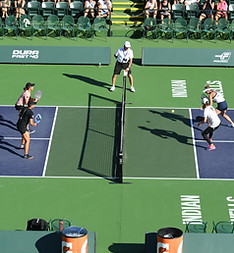The Offensive LOB for Beginners
To be a successful lobber from the kitchen line, one of the most important aspects to focus on is your ability to disguise the shot. You need to dink the ball and lob the ball with the exact same smooth pendulum motion.
Dinking 101: 5 Steps to a Winning Dink
Here at Pickleball Channel we talk a lot about dinking, or the soft game, but what exactly is a dink, and how can it improve your game? Today we're going to go back to the basics and hear from pickleball ambassador, Tom Earley, in one of our most popular shows, “Pickleball 411”.

READ MORE
By Pat Brooks
Instructional articles
When to Lob
Utilizing a lob is a great tactic in offensive play at the NVL
By Sarah Ansboury

Utilizing a lob is a great tactic in offensive play at the NVL. Timing is the most important aspect of lobbing. Most often, at higher levels, lobs are used offensively from the NVL to move opponents back to the baseline to push the opposing team into defense. A lob at the wrong time can mean a player hits an overhead vs. running down for a lob, which creates a difficult position for your opponent. Pushing your opponent back to the baseline forces him/her to hit a drop shot back in the NVZ to get back to the net. If they are unable to, he/she will often lob defensively to try to create more time.
When looking for an opportunity, there are a few cues to pay attention to:
-
If your opponent’s paddle is face down toward the ground, when his/her paddle is dropped, the chances of hitting an overhead go down. -
If your opponent is hunched over, this will create a more difficult position for him/her to turn and go to the ball. -
If your opponent’s head is down—head movement is a key part to stability—the more the head moves around, the harder it is to move to the ball efficiently.
Here are a few things to remember when hitting your lob:
-
Hold your position at the NVL and do not back up—players often disengage and watch their opponents run down the ball or back up to hit a lob.
-
Expect the ball to come back—whether it’s a short overhead or a lob, expect to hit the next shot.
-
Keep your paddle above the net after you hit the lob. When the ball comes back, you want to be able to get to it quickly and keep taking time away from your opponent.
Using an offensive lob is effective at every level. The most important thing is to create it at the right time. Players often rush the lob and it ends up short. A good lob from the NVL looks very much like a dink, it’s disguised well.








